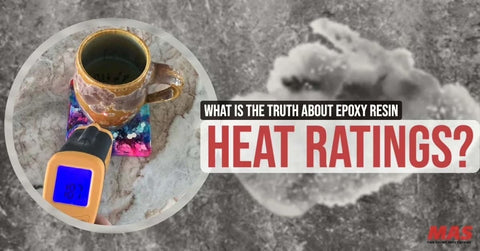What is the truth about epoxy resin heat ratings?
Tabletop epoxy ‘Heat Resistance’? What does that even mean? Can epoxy withstand heat? Does it really matter? Is that the temperature can I safely subject my epoxy counter to? All good questions, let's take a closer look!
The terms epoxy resin heat resistance, epoxy resin temperature resistance, service temperature, epoxy resin temperature rating, thermal glass transition temperature, and epoxy resin heat deflection temperature are popping up quite a bit in tabletop epoxy marketing these days, but they don’t all mean the same thing. ‘Heat Resistance’ in particular, can be a little misleading.
What is Epoxy Resin Heat Resistance?
Heat Resistance is the thermal degradation temperature at which epoxy begins to break down. The temperature at which the epoxy permanently distorts, scorches, and degrades. For room temp curing tabletop epoxy systems, that’s about 400-500°F
Wait, but this tabletop epoxy says it has a 500°F Heat Resistance…so, that must mean it’s safe to set a baking pan straight from a 450°F oven directly on top of this beautiful epoxy-coated counter, right? Nope, not quite. Heat Resistance is not the same as recommended service temperature. While a nice high 400-500°F number looks great in a product description, it in no way reflects the practical day-to-day service temperature.
The Recommended Service Temperature?
Heat Deflection Temperature (HDT) or Thermal Glass Transition Temperature (Tg) are the values you’ll want to compare for real-world usage, with HDT being the most conservative and most common. Simply put, HDT is the temperature at which cured epoxy begins to soften.
HDT is measured using a standardized ASTM D648 test method, in which a cured bar of epoxy is placed into a 3-point bend fixture, under a small load, and submerged into a heated oil bath. The bath is slowly heated at a constant rate until the bar begins to soften and deflect, at this point the temperature is recorded and the test is complete. Heat Deflection Temperature (HDT) is one of the most common ways to determine the practical service temperatures of epoxy systems and is used in the coatings, marine, and aerospace industries alike.
Conclusion
Remember, epoxy will remain a rigid solid at temps below its HDT, and will begin to soften at temps above. The higher the temperature, the softer the epoxy. Some tabletop systems have higher HDTs than others, but most are around 100-130°F. The HDT of MAS Table Top Epoxy is 124°F. For comparison, an actual 500°F system is more in line with high-end aerospace-grade manufacturing and would require an extensive high temp post cure cycle in order to achieve an HDT or Tg that high.
The best practice is to wait 5-7 days at room temp for the epoxy coating to fully cure (develop its full mechanical and thermal properties) before putting it into service. As a general rule, anything that will burn you (hot pans, boiling water kettle, etc.) could potentially leave an impression on an epoxy coating. When in doubt use a hot pad or a coaster and continue to enjoy for years to come!
Follow us for product recommendations, application methods, and how-to guides. Learn new skills or just brush up on general epoxy care and best-use practices. A great resource for first-time epoxy users, seasoned DIYers, and pros alike. If there’s a topic you’d like to know more about, we’d love to hear from you!





Comments (0)
There are no comments for this article. Be the first one to leave a message!